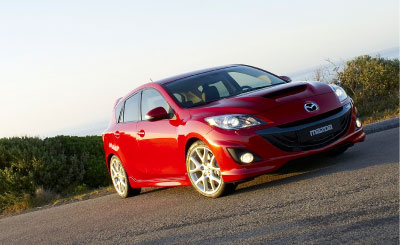With the needle pointing at 175km/h, maybe a fraction more, the new 3 MPS hangs in perfect equilibrium in the high lane of the steeply banked turn. The car doesn’t want to climb higher and closer to the barrier that surrounds the high-speed track at Mazda’s Miyoshi Proving Ground. Nor does it want to descend to a lower, slower altitude. This is the canted curve’s ‘neutral speed’, where you could let go of the steering wheel and the 3 MPS would still track true inside the fast lane.
As the horizon twists back to horizontal and a straight stretches ahead, it’s time to find out how much the Mazda has left. Downshift from sixth to fifth, blipping the engine’s revs into the high-power end of the tachometer’s arc … and floor the throttle. The 3 MPS accelerates, although not with an effortless rush. It’s obvious that much of the direct-injected 2.3-litre turbo’s power is busy muscling the Mazda’s 0.32 drag coefficient shape and its 2.217 square metres of frontal area through the mild, April air, with not a great deal left in reserve. While the Mazda ploughs past 200km/h with ease, the rate of acceleration begins to taper beyond that. There’s no doubt the MPS will reach its claimed 250km/h top speed, but this isn’t the Mazda’s natural realm.Less than an hour later I’m finding out where, exactly, the Mazda does belong. The global road circuit at Miyoshi is a favourite. Yes, it’s an entertaining track to drive, but it’s also a good place to test. It has almost everything you could want: slow corners, fast corners, smooth corners, rough corners, flat corners, rising corners, diving corners … and (take a breath) a long straight.As our pre-production 3 MPS is the only car using the track (Mazda has shut down testing for 90 minutes, just for Wheels) I can stop on the straight for a standing-start launch, or six. It’s soon obvious the car’s standard ESP is best left on. It’s a pretty polished system that does a good job of delivering a swift take-off with a minimum of torque-wasting wheelspin. Switching the system off makes it abundantly clear how much it does. Without ESP active, popping the clutch with anything over about 2000rpm showing on the tach is going to get you instant, wild wheelspin. It happens despite the inclusion of a standard limited-slip differential, and faster than you can think about easing pressure on the throttle to re-establish grip.Mazda quotes a 6.1sec 0-100km/h time, and the car certainly feels capable of something close to this number. Although the new 3 MPS is a little heavier and the engine’s max power output practically unchanged at 191kW, the slightly taller ratios inside the six-speed gearbox lend some cred to the claim. Where the first-generation (best Wheels-recorded 0-100km/h time 6.4sec) needed third gear to make it to 100km/h, the new one apparently reaches the benchmark at the very top end of second.The most notable thing about the new MPS’s undiminished performance is its character. It’s as quick as ever, yet much less busy. Where the old one was a torque-steering handful, this one’s 380Nm are barely felt through the wheel when launching from rest or flooring the throttle to slingshot out of a second-gear corner. Only when pushing hard through Miyoshi’s lumpiest corner – a right-hander that uses every millimetre of the suspension travel front and rear, and has the car skipping sideways – is there any steering tug worthy of mention.Through the circuit’s smoother bends, the steering is remarkable only for its precision and feel. The 3 MPS is set up for mild understeer, and you can feel its onset quite clearly through the rim. You can hold the MPS right on the cusp of front-tyre slip, into and out of corners. Or you can ignore the quality of the steering, and slap it brutishly from apex to apex, letting the sweetly subtle ESP tidy up after you. Switch the system off, and you’ll find that the Mazda really is nicely balanced and inherently stable.Both clutch and six-speed manual have the right combo of weight and feel. The effective brakes grew a little whiffy at times, but never felt like fading. The level of drivetrain refinement is just right, with a sonorous exhaust rumble around 3500rpm that’s characterful rather than annoying. Finally, ride comfort is better than expected (and remembered from the first-generation 3 MPS).That the new MPS is a more polished drive than its predecessor is undeniable. And there’s no reason to doubt that it’s every bit as quick as its predecessor, although the new car’s greater sophistication may create the impression it’s slower. This may not be what every hot-hatch customer wants; there are plenty who prefer drama to calmer…But whether everyone approves of the 3 MPS’s new flavour or not, what Mazda’s engineers have achieved is impressive. They have, after all, transformed the 3 MPS while recycling much of the first model’s hardware.Yoshiyuki Maeda, program manager for the entire new Mazda 3 line-up, confirms the changes to the MPS’s engine are minor. Mazda didn’t want any more power, but did want Euro 5 compliance, requiring small changes to the cylinder head design and a rework of engine management electronics.While power hasn’t increased, performance reliability has been improved. The switch from the first 3 MPS’s underbonnet intercooler duct to a bonnet scoop for the new model is the key, Maeda explains. “Like in Australia, even in the circumstance of the 35 celsius degree, the intercooler cooling efficiency can be maximised,” Maeda said. This means less decline in power as temperature rises.Inside the six-speed manual (largely carried over from the first-gen 3 MPS), first to fifth gears are all a little taller. The aim here was to make the car’s performance more accessible more of the time. And while the 3 MPS’s brake discs and calipers remain the same, the power assist was recalibrated. As was the ESP system.Changes to the body and chassis, however, were substantial. And it’s these that are responsible for altering the 3 MPS’s previously manic character. “The body rigidity [is] much improved. Also, the suspension rigidity [is] improved as well,” Maeda says. These gains gave his chassis engineers a wider range of damper and bush tuning options with which to work. “That’s the reason why the steering feels much improved.” A third, additional, fixing point for the steering rack, compared to the first-gen car, also contributes to the palpable improvement in steering accuracy, he adds.At the same time as the engineers were working to make the new 3 MPS a more serene drive, the design department was striving to make it look wilder than ever. As with the intercooler scoop, which design wanted every bit as much as engineering, the changes were often good for both departments.There was a big difference between the understated appearance of the first-gen 3 MPS, and its manic performance. In contrast, the second-gen model looks like something potent, yet delivers serious speed in a much more civilised manner.In every sense, the second 3 MPS is better balanced than the first, and its new-found equilibrium makes it a more desirable car.
Mazda 3 MPS
Body steel, 5 doors, 5 seats Drivetrain front-engine (east-west), front-drive Engine 2261cc in-line four, dohc, 16v, turbocharger Power 191kW @ 5500rpm Torque 380Nm @ 3000rpm Transmission 6-speed manual Size l/w/h 4505/1770/1460mm Wheelbase 2640mm Weight 1472kg (estimate) 0-100km/h 6.1sec (claimed) Price $40,000 (estimated) On sale August






